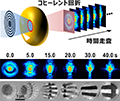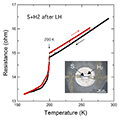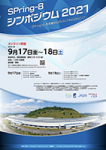Volume 26, No.4
Autumn issue 2021
1. 最近の研究から/FROM LATEST RESEARCH
京都大学 複合原子力科学研究所 Institute for Integrated Radiation and Nuclear Science, Kyoto University
- Abstract
- 今から46億年前に、誕生したばかりの太陽の周囲で小天体が衝突と合体を繰り返した結果として、地球型の惑星が形成された。これらの小天体では衝撃圧縮による鉱物の結晶構造の相転移が頻繁に起きていたと考えられ、その痕跡である高密度の構造が隕石に残されていた。我々はこの高密度構造の生成の過程を超高速のコマ送り動画の形で計測した。集光した高強度パルスレーザーの結晶への照射によって衝撃圧縮を引き起こし、その直後に同じ場所に集光したフェムト秒X線パルスによって結晶の原子配列の変化を計測した。この実験による衝撃圧縮の開始からわずか数ナノ秒の後に高密度構造が生成した。この速さは従来の見解を覆すものであった。小天体の衝突の際には短時間の圧縮は頻繁に起こるので、速い相転移の記録が隕石や小惑星サンプルリターン試料に残されている可能性は高い。それらを丁寧に探していけば、太陽系の衝突の歴史を具体的に描けるだろう。
兵庫県立大学 大学院理学研究科 Graduate School of Science, University of Hyogo
- Abstract
- デバイスや材料のナノメートルからマイクロメートルに亘る空間階層構造と機能特性の相関解明を目指し、コヒーレント回折イメージング(CDI)と呼ばれるレンズレスイメージング法の開発を進めてきた。特にオペランド下や機能環境下でのその場観察に向けて、大気環境下で計測可能な硬X線CDI及びタイコグラフィシステムを兵庫県IDビームラインBL24XUに構築し、電子顕微鏡では観察が難しい湿潤ガスや酸化還元ガス雰囲気下でのミクロンサイズ機能性粒子の構造応答可視化や実用材料の三次元構造解析を産業界ユーザーと共同で進めてきた。更に、機能中の構造動態の可視化に向けて、時分割イメージング法であるマルチショットCDIを独自に開発し、10−100 fpsと従来より100倍以上高い時間分解能での動的ナノイメージングを実現した。
大阪大学 核物理研究センター Research Center for Nuclear Physics, Osaka University
- Abstract
- BL31LEP(LEPS2ビームライン)では、GeVエネルギー領域の光子ビームを用いた原子核ハドロン実験を行っている。GeV光子ビームはSPring-8蓄積リングにレーザー光を入射し、8 GeV電子との逆コンプトン散乱により生成している。LEPS2実験棟において2014年から開始したBGOegg実験では、η'中間子をプローブとしたハドロンの質量起源を探る実験が行われている。本報告では、BL31LEPビームラインの紹介、およびハドロンの質量生成機構を探る鍵となるη'中間子−原子核束縛状態探索実験の結果を報告する。
東北大学 金属材料研究所 Institute for Materials Research, Tohoku University
大阪大学 基礎工学研究科附属極限科学センター 超高圧研究部門 KYOKUGEN, Graduate School of Engineering Science, Osaka University
- Abstract
- 本研究は、メガバール(=1 Mbarは、106気圧=100万気圧)を超える圧力領域の物質科学を新展開させると同時に、これまで為し得なかった物質創造に挑戦する、科学研究費補助金(特別推進研究)「超高圧力下の新物質科学:メガバールケミストリーの開拓」(H26~30)の研究推進に不可欠な超高圧力下の構造科学の推進を目的としている。これは、実験責任者がこれまで発展させてきた高圧力下の物質研究を強化して、超高圧の世界に隠されている新奇物性を解き明かし、新現象や新物質を創成し、革新的な材料開発につながる新しい固体物理の構築につなげることを目指したものである。
[1]The Ritchie Centre, Hudson Institute of Medical Research / Department of Obstetrics and Gynaecology, Monash University、[2]School of Physics and Astronomy, Monash University
- Abstract
- The clearance of airway liquid at birth represents a major challenge for newborn infants and must be accomplished within a few minutes of birth to allow the onset of pulmonary gas exchange. While the majority of infants perform this task with remarkable ease, up to 20% of infants require some sort of assistance to make this transition. Phase contrast X-ray imaging studies at SPring-8 have uncovered some of the mysteries behind this process, showing that liquid is cleared from the airways into lung tissue due to pressure gradients generated by inspiration or positive pressure inflations. While the newborn is well adapted to cope with the resulting lung oedema, its capacity to do so is limited. Thus, when airway liquid volumes are high at the onset of air breathing the infant can suffer respiratory distress after birth, which usually develops within 1-2 hours of birth and is 4 times more likely to occur in infants born by caesarean section at or near term. Subsequent studies at SPring-8 have now explained the pathophysiology associated with this form of respiratory distress and shown that it arises from the newborn having a larger than normal volume of liquid present within the airways at the onset of air-breathing. As a result, larger than normal volumes of liquid must be accommodated within lung tissue following lung aeration, which causes excessive pulmonary oedema; the larger the volume, the greater the oedema. This type of pathophysiology is very similar to the pulmonary pathophysiology suffered by patients with a severe COVID-19 infection. As such, improving our understanding of how newborns cope with moderate levels of pulmonary oedema and remove this liquid from lung tissue may improve our understanding of how to treat COVID-19 patients with severe respiratory distress.
2. 研究会等報告/WORKSHOP AND COMMITTEE REPORT
(公財)高輝度光科学研究センター 放射光利用研究基盤センター 回折・散乱推進室 Diffraction and Scattering Division, Center for Synchrotron Radiation Research, JASRI
(公財)高輝度光科学研究センター 放射光利用研究基盤センター 産業利用基盤開発推進室 Industrial Platform Development Division, Center for Synchrotron Radiation Research, JASRI
(公財)高輝度光科学研究センター 放射光利用研究基盤センター 精密分光推進室 Precision Spectroscopy Division, Center for Synchrotron Radiation Research, JASRI
(公財)高輝度光科学研究センター 放射光利用研究基盤センター 回折・散乱推進室 Diffraction and Scattering Division, Center for Synchrotron Radiation Research, JASRI
[1]SPring-8ユーザー協同体(SPRUC)行事幹事/筑波大学 数理物質系 Faculty of Pure and Applied Sciences, University of Tsukuba、[2]岡山大学 異分野基礎科学研究所 Research Institute for Interdisciplinary Science, Okayama University
3. SPring-8/SACLA通信/SPring-8/SACLA COMMUNICATIONS
(公財)高輝度光科学研究センター 放射光利用研究基盤センター 分光推進室 Spectroscopy Division, Center for Synchrotron Radiation Research, JASRI
(公財)高輝度光科学研究センター 放射光利用研究基盤センター 散乱・イメージング推進室 Scattering and Imaging Division, Center for Synchrotron Radiation Research, JASRI
(公財)高輝度光科学研究センター 放射光利用研究基盤センター 精密分光推進室 Precision Spectroscopy Division, Center for Synchrotron Radiation Research, JASRI
(公財)高輝度光科学研究センター 放射光利用研究基盤センター タンパク質結晶解析推進室 Protein Crystal Analysis Division, Center for Synchrotron Radiation Research, JASRI
4. 談話室・ユーザー便り/USER LOUNGE・LETTERS FROM USERS
SPring-8ユーザー協同体(SPRUC)会長/広島大学 大学院先進理工系科学研究科 Graduate School of Advanced Science and Engineering, Hiroshima University

















